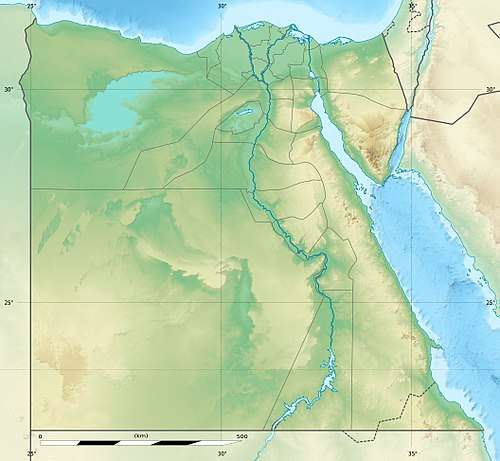Qasr el Sagha Formation
The Qasr el Sagha Formationis a geological formation located in Egypt[1] The formation is part of the Wadi El Hitan World Heritage Site. The Qasr el Sagha Formation overlies the Birket Qarun Formation and is overlain by the Gebel Qatrani Formation. The sandstones and shales of the formation were deposited in a deltaic to shallow marine environment.[2] It dates to the Late Eocene (middle Priabonian,37.2 to 33.9 million years ago).[3]
| Quasr el Sagha Formation Stratigraphic range: Priabonian ~37–34 Ma | |
|---|---|
| Type | Geological formation |
| Sub-units | Dir Abu Lifa & Temple Members |
| Underlies | Gebel Qatrani Formation |
| Overlies | Birket Qarun Formation |
| Lithology | |
| Primary | Sandstone |
| Other | Mudstone |
| Location | |
| Location | Fayum District |
| Coordinates | 29.5°N 30.5°E |
| Approximate paleocoordinates | 24.9°N 26.5°E |
| Country | |
| Extent | Wadi El Hitan |
 Qasr el Sagha Formation (Egypt) | |
Paleontological significance
Fossils of the early whale genus Saghacetus ("Sagha whale", originally named "Zeuglodon osiris") were first collected at Qasr al Sagha by German explorer Georg August Schweinfurth in January 1886 (a well-preserved dentary).Saghacetus is common in the middle of Qasr el Sagha, but there are few other specimens of archaeocetes whales; the only exception being the enigmatic "Prozeuglodon stromeri", named in 1828 based on specimens from 1904, but never adequately described before their destruction during the bombing of Munich in World War II.[4]
Fossil content
Other fossils found in the formation include:[5]
- Mammals
- Reptiles
- Andrewsemys libyca
- Fish
- Misrichthys stromeri
- Carcharhinus aff. frequens
- Odontorhytis aff. pappenheimi
- ?Jacquhermania attiai
- Carcharhinus sp.
- Coupatezia sp.
- Ouledia sp.
- Pastinachus sp.
- Rhinobatos sp.
- Scyliorhinus sp.
- ?Sphyrna sp.
- Pristidae indet.
- "Cretolamna" twiggsensis
See also
References
- Vickers-Rich & Rich 1993
- Gingerich et al., 2019
- Tamariskenbucht (Eocene of Egypt) in the Paleobiology Database. Retrieved July 2013.
- Gingerich 2007, pp. 363–4
- Qasr el Sagha Formation at Fossilworks.org
Bibliography
- Gingerich, Philip D.; Mohammed Sameh M. Antar, and Iyad S. Zalmout. 2019. Aegicetus gehennae, a new late Eocene protocetid (Cetacea, Archaeoceti) from Wadi Al Hitan, Egypt, and the transition to tail-powered swimming in whales. PLoS ONE 14. e0225391. doi:10.1371/journal.pone.0225391 PMID 31825956 PMC 6905522
- A. Pérez-García. 2019. New information and establishment of a new genus for the Egyptian Paleogene turtle ‘Stereogenys’ libyca (Podocnemididae, Erymnochelyinae). Historical Biology 31(3):383-392
- S. Adnet, H. Cappetta, S. Elnahas and A. Strougo. 2011. A new Priabonian Chondrichthyans assemblage from the Western desert, Egypt: Correlation with the Fayum oasis. Journal of African Earth Sciences 61:27-37
- Gingerich, Philip D (2007). "Stromerius nidensis, new archaeocete (Mammalia, Cetacea) from the Upper Eocene Qasr El-Sagha Formation, Fayum, Egypt" (PDF). Contributions from the Museum of Paleontology. 31 (13): 363–78. OCLC 214233870.CS1 maint: ref=harv (link)
- Vickers-Rich, Patricia; Rich, Thomas Hewitt V. (1993). Wildlife of Gondwana. Indiana University Press. ISBN 0-7301-0315-3.CS1 maint: ref=harv (link)